
Tarragon, also known as estragon, is a species of perennial herb in the family Asteraceae. It is widespread in the wild across much of Eurasia and North America and is cultivated for culinary and medicinal purposes.

Artemisia I of Caria was a queen of the ancient Greek city-state of Halicarnassus, which is now in Bodrum, present-day Turkey. She was also queen of the nearby islands of Kos, Nisyros and Kalymnos, within the Achaemenid satrapy of Caria, in about 480 BC. She was of Carian-Greek ethnicity by her father Lygdamis I, and half-Cretan by her mother. She fought as an ally of Xerxes I, King of Persia against the independent Greek city states during the second Persian invasion of Greece. She personally commanded her contribution of five ships at the naval battle of Artemisium and at the naval Battle of Salamis in 480 BC. She is mostly known through the writings of Herodotus, himself a native of Halicarnassus, who praises her courage and relates the respect in which she was held by Xerxes.

Artemisia is a large, diverse genus of plants belonging to the daisy family Asteraceae, with between 200 and 400 species. Common names for various species in the genus include mugwort, wormwood, and sagebrush.

Artemisia II of Caria was a naval strategist, commander and the sister and the successor of Mausolus, ruler of Caria. Mausolus was a satrap of the Achaemenid Empire, yet enjoyed the status of king or dynast of the Hecatomnid dynasty. After the death of her brother/husband, Artemisia reigned for two years, from 353 to 351 BCE. Her ascension to the throne prompted a revolt in some of the island and coastal cities under her command due to their objection to a female ruler. Her administration was conducted on the same principles as that of her husband; in particular, she supported the oligarchical party on the island of Rhodes.

Artemisia Lomi or Artemisia Gentileschi was an Italian Baroque painter. Gentileschi is considered among the most accomplished seventeenth-century artists, initially working in the style of Caravaggio. She was producing professional work by the age of 15. In an era when women had few opportunities to pursue artistic training or work as professional artists, Gentileschi was the first woman to become a member of the Accademia di Arte del Disegno in Florence and she had an international clientele.

Artemisia absinthium, otherwise known as common wormwood, is a species of Artemisia native to North Africa and temperate regions of Eurasia, and widely naturalized in Canada and the northern United States. It is grown as an ornamental plant and is used as an ingredient in the spirit absinthe and some other alcoholic beverages.
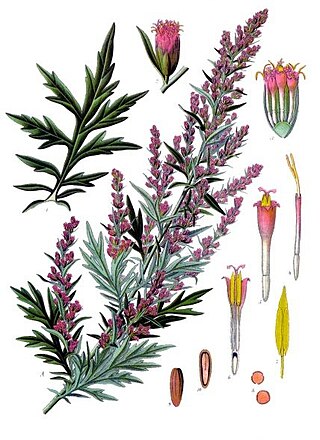
Mugwort or biboz is a common name for several species of aromatic flowering plants in the genus Artemisia. In Europe, mugwort most often refers to the species Artemisia vulgaris, or common mugwort. In East Asia the species Artemisia argyi is often called "Chinese mugwort" in the context of traditional Chinese medicine, Ngai Chou in Cantonese or àicǎo (艾草) in Mandarin. Artemisia princeps is a mugwort known in Korea as ssuk (쑥) and in Japan as yomogi (ヨモギ). While other species are sometimes referred to by more specific common names, they may be called simply "mugwort" in many contexts.

Scrobipalpa is a genus of moths in the family Gelechiidae. Euscrobipalpa has sometimes been treated as a distinct subgenus, or even as a full genus, but is generally no longer recognised as valid, following Ponomarenko & Park (2007).
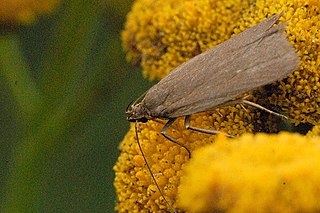
Scrobipalpa acuminatella is a moth of the family Gelechiidae. It is found in most of Europe, as well as Turkey, southern Siberia, Central Asia and China (Anhui). It was recently reported from Canada, with records from Ontario and Québec.
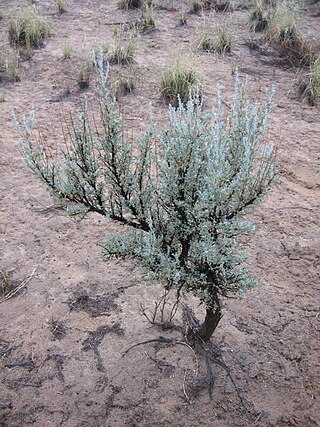
Sagebrush is the common name of several woody and herbaceous species of plants in the genus Artemisia. The best known sagebrush is the shrub Artemisia tridentata. Sagebrushes are native to the North American west.
Scrobipalpa indignella is a moth of the family Gelechiidae. It is found in southern Russia, Ukraine, and from the Near East and Middle East to Afghanistan and China (Xinjiang).
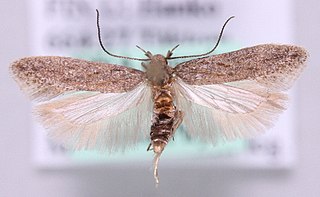
Scrobipalpa nitentella, the common sea groundling, is a moth of the family Gelechiidae. It is found in most of Europe, North Africa (Tunisia), Turkey, Afghanistan, Kazakhstan, China, Mongolia and Siberia (Transbaikalia).

Scrobipalpa proclivella is a moth of the family Gelechiidae. It is found in large parts of Europe, east to the southern Ural Mountains and Siberia.
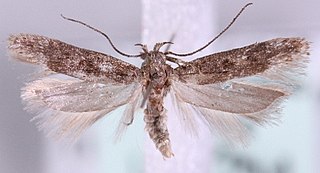
Scrobipalpa salinella, the sea-aster groundling, is a moth of the family Gelechiidae. It is found Europe, along the coast and in inland halophytic habitats. In the east, the range extends through Siberia and Central Asia to Mongolia. It is also found in North Africa.

Scrobipalpa samadensis, the buck's-horn groundling, is a moth of the family Gelechiidae. It is found in most of Europe and Russia.
Scrobipalpa rebeli is a moth of the family Gelechiidae. It is found in Austria, Italy, Ukraine and the Krasnoyarsk region in southern Siberia. It is also present in China (Shaanxi) and Japan.
Scrobipalpa ergasima is a moth of the family Gelechiidae. Edward Meyrick first used the scientific name in 1916. It is found in the Mediterranean Region and on the Canary Islands. Outside of Europe, it is found in Egypt, Saudi Arabia, the Democratic Republic of the Congo, Namibia, South Africa, Sudan, Australia, India, Indonesia, Myanmar and Pakistan.
Scrobipalpa chrysanthemella is a moth in the family Gelechiidae. It was described by Ernst Hofmann in 1867. It is found in Germany, Austria, Switzerland, Italy, the Czech Republic, Slovakia, Serbia, Bosnia and Herzegovina, Hungary, Romania, Russia and Turkey.
Scrobipalpa disjectella is a moth in the family Gelechiidae. It was described by Staudinger in 1859. It is found in Algeria, Spain and Kyrgyzstan.
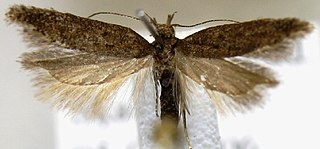
Scrobipalpa pauperella is a moth in the family Gelechiidae. It was described by Hermann von Heinemann in 1870. It is found in Great Britain, Luxembourg, Spain, France, Germany, Austria, Switzerland, Italy, the Czech Republic, Slovakia, Poland, Hungary, Romania, Ukraine, Belarus, Estonia, Latvia, Russia, Sweden, Finland, Afghanistan, Transbaikal and China.















